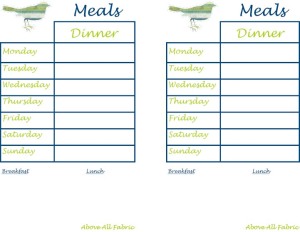Menu planning: Eat healthier and spend less

Menu planning is a great way to provide your family members with a variety of healthy foods that meet their nutritional needs. Menu planning also saves time and money.
Save money

Start worrying about what to have for dinner
When the clock approaches 5:00 p.m., do you start worrying about what to have for dinner? Are you always scrambling for an answer? If so, try this old-school trick that's back in fashion — menu planning. Menu planning is a great way to make sure you're providing your family members with a variety of healthy foods that meet their nutritional needs. And, as every frugal cook knows, menu planning can also save both time and money.
How does menu planning save time and money?
Just consider how much time you spend standing in front of your refrigerator looking for something for dinner.
Or maybe you often end up eating out, which takes a big bite out of your budget.
In addition, if you eat out a lot — especially at fast-food joints — you're probably not eating as healthfully as you should.

No Healthy Junk Foods
Finally, think about the food that goes to waste because you bought it without a plan for how to use it.

Eat Healthy with Menu Planning
With menu planning you know what to buy, which makes your grocery shopping more efficient and reduces the need for unplanned trips to buy one or two items. And with a grocery list in hand — a byproduct of good menu planning — it's easier to resist overspending on food you won't use or don't need.
Getting started

Menu planning doesn't have to be complicated. To get started, jot down some of your family's favorite meals. Flip through cookbooks or look online for recipe ideas. Check the weekly food ads for sales.

Now get writing. If you're planning for the next week, create a grid or use a calendar and jot down your ideas for meals under each day. You can start by just planning dinners. Make sure to include side dishes as well as entrees, and maybe some healthy desserts. If you're feeling ambitious, add some healthy lunch and snack options for the week as well. When you have your menu plan filled in, create a shopping list of the ingredients you'll need. Some things to consider as you contemplate meal options:

Meal Planning Kit
- Think seasonal. What fresh produce is available this time of year? Is it salad season or soup weather?


Fresh Organic Fruits Salad
- Consider what's on sale and on hand. What's on sale this week at the supermarket? What's in your pantry?

Food on Sale
- Mix things up. Keep the menu interesting by planning some meatless meals or substituting breakfast for dinner. Alternate new recipes and old favorites.

- Picture the plate. Here's a trick for making sure your meals include appropriate portions of key food groups: As you plan a meal, keep in mind that fruits or vegetables should cover half your dinner plate, and lean protein and whole grains should each take a quarter of the plate.





No comments:
Post a Comment